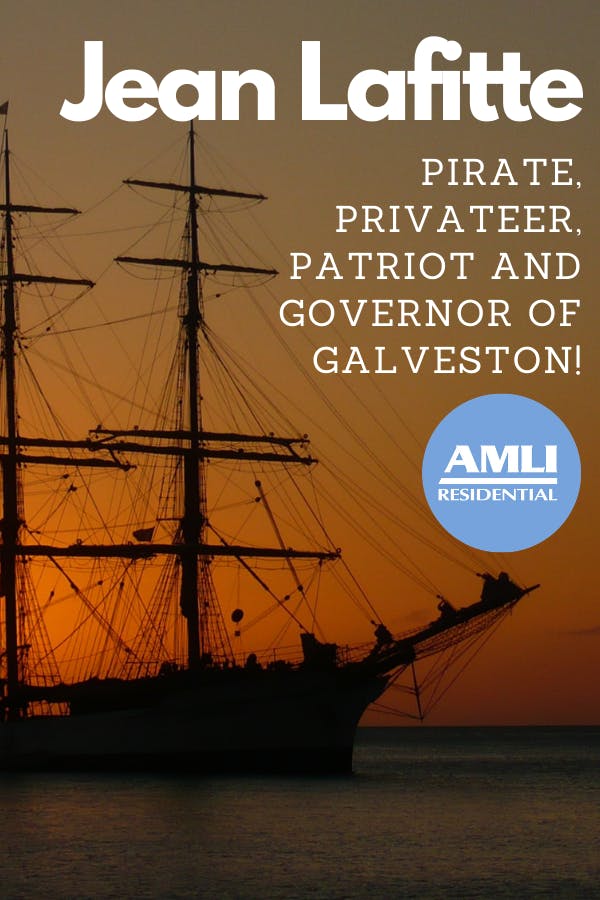Everyone likes a good pirate story; just ask Johnny Depp!
Pirate stories are filled with adventure, danger, excitement and, of course, plenty of treasure. It’s fun to imagine a life where roaming the crystal-clear Caribbean under blue skies with a merry band of mates is an everyday occurrence, but we all know that reality is not quite the same as the story.
Unlike Jack Sparrow, there are plenty of pirates who really did roam the seas around the Caribbean in fairly recent history. Blackbeard, arguably the most famous pirate in Western history, ruled the waters around South Florida and the Atlantic, while Black Caesar rose to fame as one of the most ruthless pirates in the Florida Keys.
When we think of pirates, we generally think of the Caribbean and South Florida, but did you know that one 18th-century Caribbean pirate had a significant role in establishing the Texas city of Galveston?
If Jean Lafitte were here today, he would probably scoff at the pirate title we so casually attach to his name, as he also served as a privateer, governor and business owner in Louisiana and Texas (alongside his, ahem, pirating activities, of course).
If you live in our luxury Houston apartments, then you’ve probably driven through Jean Lafitte’s old territory without ever even knowing it! The famed pirate retired in what we know as Galveston today after a long and brilliant career on the Gulf seas, so here’s a little bit about Houston’s favorite pirate!
Jean Lafitte’s origins
Although we don’t know his exact date of birth (sorry, party-planning committee), we do know that Jean Lafitte was most likely born somewhere on the coast of France around the year 1780. However, there are also suggestions that he may have been born in Saint-Domingue in Haiti, which was a French colony at the time. Either way, it’s generally assumed that Jean Lafitte was born to French parents in either France or one of its colonies, and that his early years were spent near or on the water.
Whichever way Jean Lafitte grew up, he ended up in New Orleans as a young man with his brother, Pierre Lafitte, with whom he allegedly shared a blacksmith business.
This blacksmith business served as a front to an illicit smuggling operation, as New Orleans was a popular entry port into Louisiana for both merchants and pirates to sell their wares. When the United States enforced an embargo on foreign goods in 1807, though, there wasn’t enough trade coming into the port for legal businesses to survive. The black market was the only way many plantations and farms could buy the goods they needed.
Jean Lafitte’s Baratarians
Jean Lafitte assembled a crew of pirates, led by his brother Pierre, and set them loose in the waterways and swamps just south of Louisiana. The pirates attacked and looted Spanish ships, then smuggled the goods back to Jean Lafitte for him to sell to his buyers. The area in which the pirates prowled was called Brataria, and so the pirates called themselves Bratarians.
There were at least four ships in Jean Lafitte’s pirate fleet: the Sarpis, the Petit Milan, the La Dilidente and the Dorada. As cool as it would be to think that these ships bore the traditional skull and crossbones of pirate legend, these pirates were of the more legal kind and most likely flew under a provincial flag!
After liberating itself from Spanish rule in 1811, the city of Cartagena in present-day Colombia paid sailors to attack Spanish ships and gave them permission to keep all their plunder, and in return the ships would fly under the flag of Cartagena. These paid sailors were called privateers, and privateering was a common practice back in the day of naval warfare.
The War of 1812
Jean Lafitte went through a bit of a career change in 1812 when he was offered $30,000 ($622,814.29 today!) by the British government to join their fight against the United States. In true pirate fashion, Lafitte agreed, took the money, then promptly turned around and alerted U.S. forces in Louisiana.
However, Governor W.C.C. Claiborne of Louisiana didn’t believe Lafitte’s warning and instead ordered his men to destroy Lafitte’s Bratarians. The Bratarians escaped the ordeal with only a few resources left.
The governor offered a reward of $300 for the capture of Jean Lafitte, who had broken out of prison, and Lafitte responded by posting his own flyers offering $1,000 for the capture of the governor. Lafitte’s poster was just a joke, but what a baller move.
Lafitte wasn’t ready to abandon New Orleans yet, though, so he offered his services to Andrew Jackson, who agreed to let the Batarians help protect the city from the British in the Battle of New Orleans, the battle which ultimately ended the War of 1812. .
Retirement (or not?)
After his contracts with the U.S. government ended, Lafitte picked up and moved his crew and his business to the Texas barrier islands and set up shop on Galveston Island in 1817. He called his new smuggling base Gálvez, which is where the name Galveston comes from.
His new smuggling operation flourished for a few years until the U.S. government ran him out of the area in 1821. By then, he had served as governor of the island and established a successful smuggling operation from the region.
While no one knows what happened to Jean Lafitte after he was kicked out of Gálvez, some assume that he travelled down the coast, plundering and pillaging as he pleased.
Jean Lafitte was a jack-of-all-trades. He was a businessman, a pirate, a privateer, a governor, a merchant and even a captain in the United States Navy for a brief period of time. Plus, he established Galveston as a settlement, even though he was only there a short while. What a cool pirate!
Pin it!

Featured photo courtesy Pixabay/agnesti


 View All Posts by Colleen Ford
View All Posts by Colleen Ford